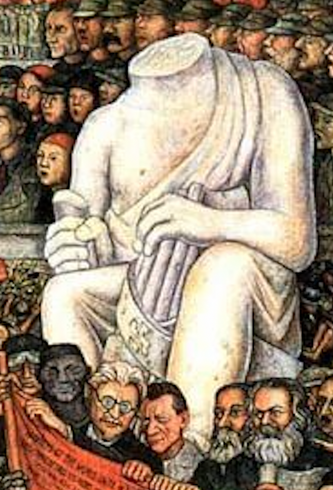PORTRAITS OF PROFIT - DIEGO RIVERA
- Mustafa Juzer
- Aug 22, 2023
- 3 min read
Updated: Sep 17, 2023
Welcome to "PORTRAITS OF PROFIT," a blog series that delves into the world of art and its depiction of one of the most influential economic systems in history: capitalism. In this series, we embark on a thought-provoking exploration, examining how artists across different periods have used their creative expressions to illuminate the complexities, critiques, and societal implications of capitalism.
A prominent figure in the world of art, Diego Rivera crafted compelling murals that served as powerful commentaries on societal dynamics. One of his notable works, "Man at the Crossroads" provides a powerful depiction of capitalism and the societal struggles associated with it.
Crafted in the early 1930s, this mural was commissioned for the Rockefeller Center in New York City but was controversially destroyed due to its political content. However, surviving sketches and Rivera's intent shed light on its portrayal of capitalism.
Understanding the mural's context and composition is enhanced by references from renowned books.

"The Making of the New Deal: The Insiders Speak" by Katie Louchheim offers insights from New Deal insiders that contextualize Rivera's mural.
The book explores the social and political climate of the 1930s, shedding light on the debate surrounding capitalism and art's role in addressing societal issues.
This contextualization underlines Rivera's intention to depict the dichotomy between industrial progress and the struggles of the working class in "Man at the Crossroads."

Furthermore, "Diego Rivera: The Detroit Industry Murals" by Linda Bank Downs and Juan Rafael Coronel Rivera delves into Rivera's thought process and influences.
It discusses how Rivera's Paris experiences and admiration for Impressionists shaped his style, influencing his portrayal of capitalism and societal conflicts in his murals.
The Detroit Industry Murals also reflect Rivera's commitment to labor and the clash between tradition and industrial progress.
Within the context of the "frontiers" of capitalism and socialism, Rivera's mural stands as a representation of the ideological struggle that shaped the 20th century.
The tension between individualism and collective well-being, topics extensively examined in "The Communist Manifesto" by Karl Marx and Friedrich Engels, is evident in Rivera's depiction of the central figure reaching out towards both directions.
This dynamic echo the dialogue on the individual's role within capitalist and socialist frameworks.
The visual composition of "Man at the Crossroads" plays a significant role in its depiction of capitalism. The central figure is a powerful representation of the common worker, embodying the struggles and aspirations of the labor force.
Surrounding this figure, Rivera incorporates intricate scenes that symbolize capitalism's effects on society. These scenes depict contrasting elements, such as laborers working in factories, intellectuals, scientists, and even contrasting political figures.

The mural's composition highlights the intersections and conflicts inherent in capitalism. Rivera employs dynamic lines, vibrant colors, and strong contrasts to draw attention to the various components of the capitalist system.
Through this composition, he emphasizes the interconnectedness of economic, social, and political forces.
Furthermore, Rivera's use of symbolism in the mural amplifies its depiction of capitalism. The presence of money, industrial machinery, and symbols of wealth juxtaposed with scenes of poverty and inequality exemplify the unequal distribution of resources under capitalism.
The inclusion of political figures, such as Lenin and Leon Trotsky, represents the ideological struggles and debates surrounding capitalism and socialism during the time.


Within the composition, two striking elements demand attention – the imposing classical sculptures flanking the mural. On the left, an enraged Jupiter holds a Christian cross and a thunderbolt, struck by lightning.
On the contrary, the right side displays a beheaded Caesar, with workers using the severed head as a bench. These sculptures encapsulate the stark contrast between power and the masses.
Rivera masterfully implies the overthrow of oppressive rulers and the shift from superstition to science. Through these visual metaphors, the mural vividly conveys the artist's stance on authoritarianism, advocating for social change and the embrace of rational thought.
In "Man at the Crossroads," Rivera challenges the dominant capitalist ideology by placing the common worker at the center of the composition, suggesting the need for social justice and workers' rights within the capitalist system.
The mural portrays the hardships faced by the working class, their contributions to industry, and the tensions between labor and capital.
Rivera's intent was to create a visual representation of the complexities and contradictions of capitalism, showcasing the potential for exploitation and inequality within the system.
By highlighting the historical context and analyzing the visual composition of the artwork, it becomes clear that "Man at the Crossroads" serves as a powerful critique of capitalism and an artistic call for social change and equality.






Comentários